AI advertising is turning digital marketing inside out.
MAI, a startup backed by $25 million from Kleiner Perkins, now manages millions in Google Ads each month using an AI agent. Their clients? They’re seeing 40% sales increases on average. Not through bigger budgets or flashier creative—through ruthlessly intelligent optimization that never sleeps.
This matters because small and medium businesses have always fought with one hand tied behind their backs. Enterprise brands deploy teams of growth engineers who monitor campaigns around the clock, tweaking bids during peak conversion windows and killing underperformers before they bleed money. The little guys either drown in dashboards themselves or hire agencies that charge steep fees for opaque results.
AI agents are changing that equation. They’re democratizing capabilities that used to require six-figure salaries and proprietary infrastructure. The question isn’t whether this technology works—the results prove it does. The question is whether the industry is ready to trust algorithms with their advertising budgets.
Why Traditional Digital Advertising Is Broken
E-commerce is growing 8% annually, outpacing even pandemic peaks. Yet the path to acquiring customers has become a minefield.
Distribution channels multiply and fragment. Google Ads, Meta, TikTok, Amazon—each with its own auction mechanics, targeting logic, and performance quirks. Direct-to-consumer brands don’t just compete with rivals anymore. They’re fighting the operational complexity of managing campaigns across platforms that speak different languages and reward different behaviors.
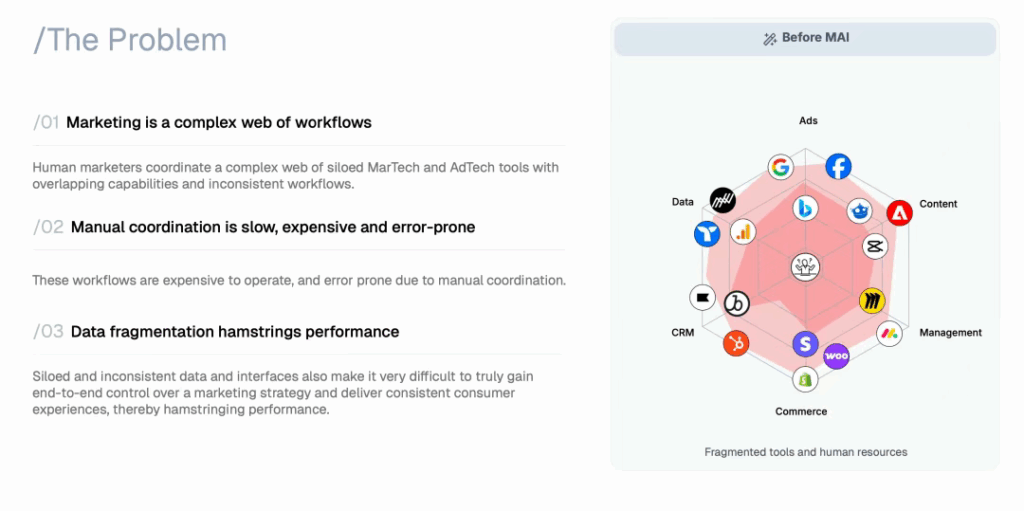
The SME Disadvantage
Small businesses face a brutal choice.
Option one: Do it yourself. Spend hours each week deciphering dashboards, adjusting keyword bids, analyzing conversion funnels. Watch your actual job—building products, serving customers—get pushed to nights and weekends.
Option two: Hire an agency. Pay 10-20% of your ad spend for reports that look impressive but rarely explain why budgets shifted or how targeting decisions were made. When campaigns tank, you get vague explanations about “market conditions” or “algorithm changes.”
Neither option is sustainable. Without dedicated growth engineers monitoring campaigns 24/7, small businesses watch competitors with bigger teams capture market share through faster optimizations and smarter targeting. The gap widens every quarter.
Mike Bires runs NutritionFaktory, a supplement brand. He summed up the agency experience like this: “Always expensive and opaque—lots of fees, but little clarity on results.”
By the time founders notice an underperforming campaign, thousands of dollars have evaporated on irrelevant clicks and wrong audiences. Money that could have scaled winners instead got burned testing losers.
The Cost of Manual Ad Management
The tactical demands are crushing.
Ads trigger for irrelevant searches because keyword management is sloppy. Duplicate campaigns compete against themselves. Weak conversion tracking makes it impossible to know which efforts actually generate revenue versus which just generate vanity metrics.
Here’s the math that kills small businesses: A company spending $5,000 monthly on ads with a 1% conversion rate and $2 cost per click gets 2,500 clicks. At $100 average order value, that’s 25 sales—$2,500 in revenue. A 50% loss.
Same budget, 3% conversion rate? That’s 75 sales, $7,500 in revenue. A 50% profit.
The difference between mediocre and excellent ad management determines whether your business survives. Most founders don’t have the expertise to hit that 3%. Most agencies don’t have the incentive to get there—they’re paid on spend, not performance.
The solution isn’t working harder. It’s automating the work entirely.
The Rise of AI Advertising Agents
Rule-based automation has been around for years. If cost-per-acquisition exceeds $50, reduce bids by 10%. If click-through rate drops below 2%, pause the ad. Simple triggers, predictable responses.
Machine learning is different. It doesn’t follow predetermined rules. It discovers patterns in data and adjusts strategies based on outcomes. The system learns what works for your business—your products, your customers, your margins—and optimizes accordingly.
That distinction matters.
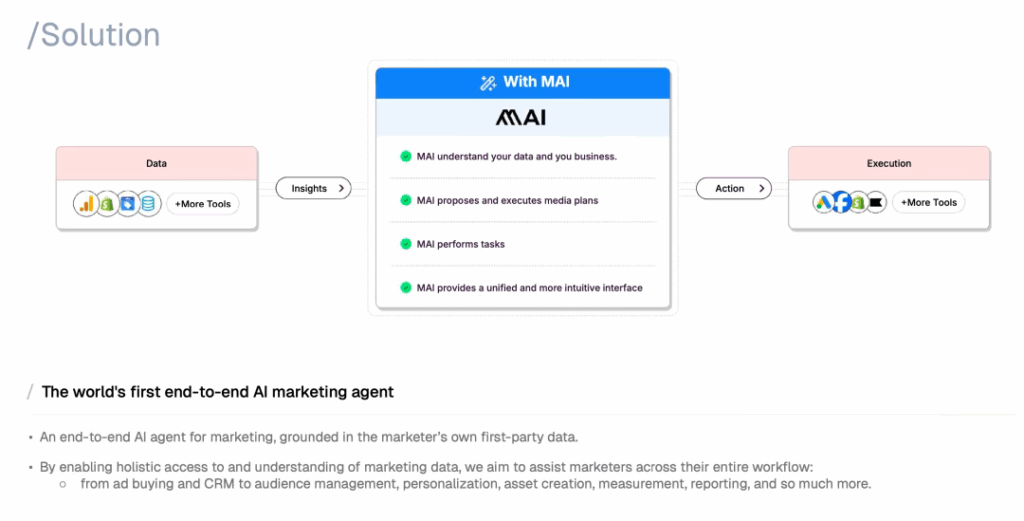
What MAI Is Doing Differently
MAI’s AI agent manages millions in Google Ads monthly, not by executing scripts but by learning from every impression, click, and conversion. The system integrates all business data—ad platforms, e-commerce, CRM—and operates continuously. When performance shifts, it adjusts in real-time. When opportunities emerge, it capitalizes immediately.
The average client sees 40% sales growth. But here’s what separates MAI from the typical “AI-powered” marketing tool: transparency.
Business owners see every optimization decision. They understand why budgets moved between campaigns. They can trace each adjustment back to revenue impact. The system detects broken discount codes before they drain budgets. It manages thousands of product variants simultaneously. It enables two-person marketing teams to handle complexity that would normally require a department.
And critically, clients keep full control of their ad accounts. No transferring ownership. No locked-in dependency.
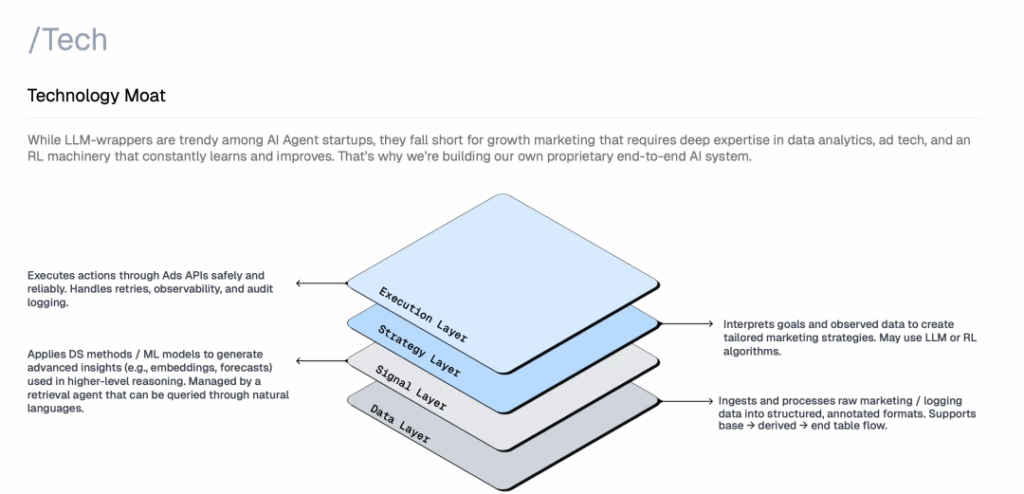
Founders’ Vision
CEO Yuchen Wu spent a decade at Google working on advertising and machine learning. He later helped Instacart scale its logistics and growth infrastructure. CTO Jian Wang built large-scale e-commerce engines at both companies.
They saw firsthand how enterprise brands leverage technology for growth. They also saw that SMEs needed the same capabilities but couldn’t afford the cost or complexity.
Their mission: democratize enterprise-level marketing.
Josh Coyne, the Kleiner Perkins partner who led their $25 million seed round, explained the investment thesis bluntly: “Performance marketing is the lifeblood of modern business, but tools to scale have long been exclusive to the largest companies. Yuchen and Jian bring a rare combination of deep ad platform expertise and empathy for growth challenges.”
That seed round—unusually large for early-stage funding—signals real conviction. Kleiner Perkins doesn’t invest in marketing automation hype. They invest in companies they believe can become category-defining. Their portfolio includes Amazon, Google, Snapchat.
MAI is doubling headcount from 12 to 24 by year-end, focusing on product and engineering. That’s the profile of a company racing to build a moat before competition catches up.
How AI Advertising Works Behind the Scenes
Understanding the mechanics reveals why these systems outperform human management. The technology operates across multiple dimensions simultaneously, processing signals and making adjustments at speeds impossible for manual oversight.
Reinforcement Learning and Real-Time Optimization
MAI’s proprietary reinforcement learning system continuously refines bids, targeting, and spend allocation. Not by following fixed rules, but through trial and error. Test different bidding strategies. Try various audience combinations. Adjust budget distributions. Reinforce what works. Abandon what doesn’t.
The algorithm discovers patterns human analysts would miss: A specific audience segment that converts exceptionally well on mobile between 8-10 PM weekdays but tanks on weekends. A creative combination that drives outsized returns in certain regions when paired with specific landing pages. Conversion spikes during particular weather patterns or news cycles.
These aren’t hypotheticals. These are the kinds of multi-dimensional patterns that emerge from analyzing millions of data points—patterns invisible in aggregated dashboard views that humans review weekly.
The system adjusts bids continuously based on device type, time of day, user behavior, competitive auction dynamics, and countless other variables. Manual bidding relies on periodic human review—daily or weekly adjustments based on lagged performance data. By the time humans notice a pattern, market conditions have shifted. The algorithm responds in hours, sometimes minutes.
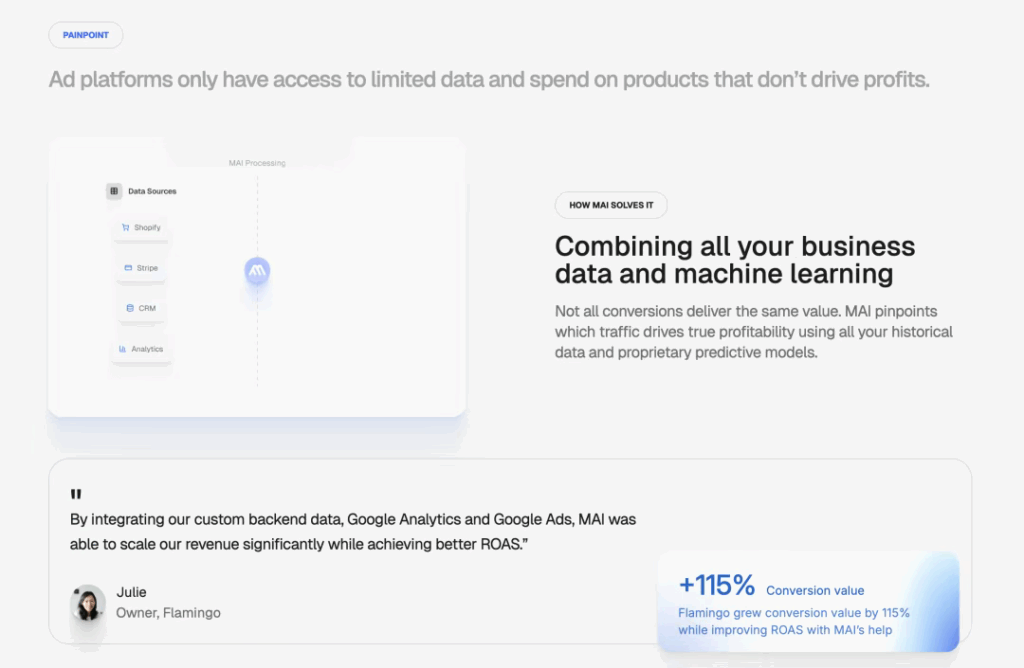
Predictive Targeting and Personalization
The most powerful capability: predicting who will convert before showing them ads.
The system analyzes purchase history, browsing behavior, engagement signals, demographics, and psychographics to identify high-value segments. It builds predictive models trained on historical conversion data, examining thousands of attributes associated with users who previously bought. Which device types? Geographic locations? Times of day? Referral sources? Browsing patterns? Previous ad interactions?
Multiple audience combinations run simultaneously. The AI compares performance across clusters and reallocates budget to the most profitable groups automatically.
This transforms advertising from spray-and-pray to surgical precision. And it identifies negative signals too—patterns associated with unlikely conversions. If users from certain referral sources consistently browse but never buy, budget shifts away. If certain demographics engage with ads but bounce immediately, targeting narrows.
Preventing waste matters as much as finding winners.
Full-Funnel Integration
Traditional ad tools optimize for clicks and impressions. Vanity metrics.
MAI integrates with e-commerce platforms, CRM systems, payment processors, and analytics tools. It tracks the complete path from initial click to final purchase to repeat purchases to lifetime value. The system understands not just who clicked, but who bought, what they bought, how much they spent, and whether they’re likely to become repeat customers.
If users clicking ads for Product A consistently purchase Product B instead, the algorithm recognizes the pattern and adjusts bidding. If mobile users convert at lower initial order values but show higher repeat purchase rates, the system accounts for lifetime value in bid calculations. If certain products drive high-margin sales while others generate low-margin volume, budget allocations reflect profitability differences.
Revenue-based optimization. Not click-based optimization.
The integration turns advertising from cost center to profit engine.
Why AI Advertising Outperforms Traditional Agencies
The comparison between AI platforms and traditional agency relationships reveals fundamental structural advantages that go beyond mere efficiency gains.
Transparency and Control
Agencies hand you polished monthly reports. Impressive charts. Positive-sounding metrics. But you rarely understand the strategic reasoning behind specific decisions. When campaigns underperform, explanations stay vague: “Market conditions shifted.” “Audience fatigue set in.” “Platform algorithms changed.”
These might be true. They don’t help you make better decisions.
MAI inverts the model. Real-time visibility into every optimization. Business owners see budget shifts as they happen. They understand why the algorithm increased bids for certain keywords and reduced others. They maintain complete account ownership—no ceding control to an external agency.
If you’re launching a new product or expecting seasonal demand shifts, you can guide the AI’s focus. You’re not waiting for an agency’s standard review cycle.
And the pricing model aligns incentives. MAI charges 10% of ad spend and guarantees specific ROAS levels. They only earn more when you profitably increase spending. If reducing spend on certain campaigns improves overall profitability, they recommend it despite lower fees.
Traditional agencies? They’re paid on spend, not performance. Subtle but persistent conflict.
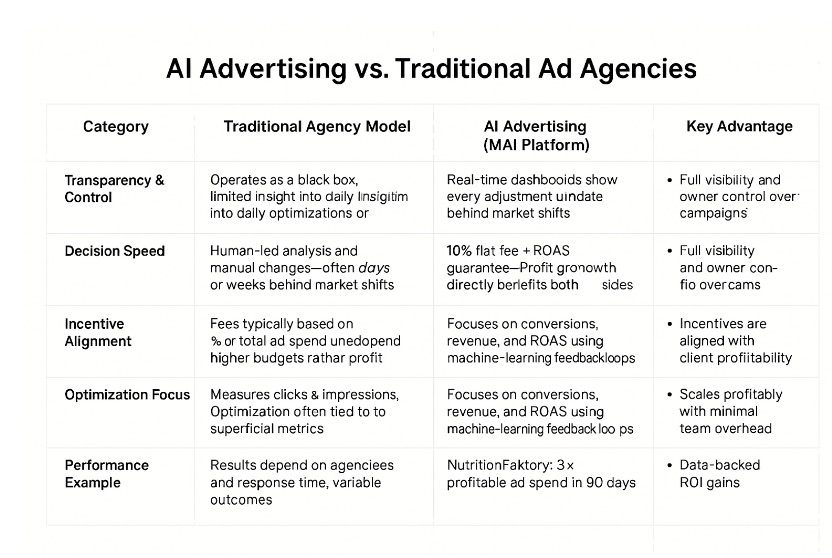
Performance and ROI
NutritionFaktory tripled profitable spend in 90 days. Peak sales and profit during their partnership with MAI. Not from spending more money, but from identifying profitable channels and scaling them efficiently while maintaining positive unit economics.
Other clients span industries: Dreo (home appliances), Fanka (consumer goods), Velotric (electric bikes), Vivaia (sustainable footwear). The 40% average sales increase isn’t isolated to one vertical. It’s cross-industry validation for automated advertising.
For a business generating $1 million annually, 40% growth means $400,000 additional revenue without discounting or increased operational costs. That additional revenue drops largely to the bottom line, enabling reinvestment in product development, inventory, or further scaling.
Maybe more valuable: reclaiming 10-20 hours weekly from campaign management. Founders can focus on building better products, strengthening customer relationships, and setting strategic direction. Activities where human judgment and creativity actually matter.
The Bigger Picture — Industry Shift to Automated Advertising
MAI’s trajectory reflects broader market forces reshaping how businesses approach AI marketing. Multiple drivers accelerate this transition from manual management to intelligent automation.
Market Drivers
Ad ecosystem complexity has exceeded human optimization capacity.
Google Ads alone offers dozens of formats, hundreds of targeting options, countless configuration settings. Add Meta, TikTok, Amazon, LinkedIn, Pinterest, Snapchat. The combinatorial complexity is staggering—millions of possible configurations across platforms.
Humans can’t monitor performance across platforms simultaneously, test variables systematically across this multidimensional space, and respond to shifts before budgets drain. AI agents handle it without fatigue or error.
Data volume compounds the challenge. Mid-sized e-commerce companies generate 10 million impressions monthly. Each impression generates dozens of attributes—device, location, time, creative variant, landing page, subsequent behavior. Extracting actionable insights from this deluge exceeds human analytical capacity.
Machine learning systems process these signals continuously, detecting multi-dimensional patterns invisible to traditional analysis. iOS users converting at 3x Android rates, but only for certain product categories during evening hours. Geographic regions showing high engagement but low conversion, indicating interest but misaligned pricing or shipping.
Then there’s speed. Consumer behavior, competitive dynamics, and seasonal trends shift rapidly. News events spike search volume. Competitor promotions depress conversion rates. Inventory shortages make campaigns unprofitable.
By the time humans notice underperformance through weekly reviews and schedule meetings to discuss adjustments, substantial budgets have evaporated. Automated platforms monitor and optimize continuously, responding within hours.
The gap between AI-optimized and manually-managed campaigns will widen. Businesses without sophisticated automation will struggle to compete on customer acquisition costs.
Human + AI Collaboration
The future isn’t AI replacing marketers. It’s division of labor based on comparative advantage.
Machines process vast data, test variables systematically, execute optimizations at scale. They don’t suffer decision fatigue, confirmation bias, or emotional attachment to strategies that stopped working.
Humans craft compelling narratives, understand emotional resonance, navigate ambiguous situations requiring judgment. They make decisions balancing multiple competing objectives beyond pure ROI—brand positioning, customer experience, long-term relationships, strategic partnerships.
As repetitive tasks migrate to AI, marketers evolve from tactical operators to strategic orchestrators. Instead of spending 80% of time on execution and 20% on strategy, the ratio inverts.
The marketing role elevates rather than diminishes. Professionals who embrace AI as leverage will thrive. Those who resist it as threat will fall behind.
Challenges Ahead for AI Advertising
Despite compelling advantages, obstacles remain before AI ad management achieves universal adoption across the industry. Addressing these challenges will determine which platforms thrive and which fade into irrelevance, and will shape how the technology evolves over coming years.
Trust and Adoption
Brands are hesitant to hand over substantial budgets to autonomous agents. Previous “automation” tools burned money and damaged trust. Rules-based scripts. Platform-native automation. Multiple waves of promises that underperformed relative to skilled human management.
This history creates skepticism.
Building confidence requires demonstrating consistent performance over time. Providing explainable decision-making rather than algorithmic black boxes. Maintaining human oversight options so businesses can intervene if needed.
Transparency becomes crucial. Show not just what the AI did (increased bids on certain keywords), but why it made those choices (conversion rates spiked for this audience segment) and how they connect to business outcomes (these changes increased ROAS from 3.2x to 4.1x, generating $15,000 additional profit).
The psychological barrier shouldn’t be underestimated. Advertising budgets often represent 10-20% of SME revenue. Trusting an algorithm with this capital requires a leap of faith many founders struggle to make.
Data, Competition, and Compliance
Data integration remains one of the hardest technical problems in marketing technology.
Every company’s tech stack differs. Various e-commerce platforms, CRM systems, analytics tools. Unifying these sources while maintaining quality, handling different formats, resolving identity across touchpoints, ensuring real-time synchronization—technically complex despite improved APIs.
Poor data leads to poor decisions. If conversion tracking breaks, the algorithm optimizes for wrong objectives. If product catalogs don’t sync, campaigns promote out-of-stock items. If CRM data contains duplicates, audience targeting degrades.
Competition intensifies as startups and major platforms invest heavily. Meta announced full ad automation by 2026. Google’s Performance Max campaigns already abstract away manual controls. MAI views these as partnership opportunities—optimizing client campaigns across platforms alongside proprietary capabilities—but competitive dynamics suggest sustainable moats require genuine technical differentiation.
Privacy regulations add complexity. GDPR, CCPA, and similar laws globally restrict data collection, require explicit consent, mandate data deletion on request, impose substantial penalties for violations. Future requirements around AI explainability may mandate showing users how algorithmic decisions were made—a technical challenge for complex ML models.
Ethical standards continue evolving. Questions around algorithmic bias, manipulation, and transparency lack clear answers but require thoughtful consideration. Platforms ignoring these concerns risk regulatory backlash and user resistance as AI literacy increases.
Strategic Takeaways for Marketers
The transition to AI-powered advertising demands thoughtful adoption strategies rather than wholesale replacement of existing processes or blind resistance to inevitable change. Marketers who navigate this transition strategically will build competitive advantages while managing risks.
Practical Steps
Start small. Test AI systems on specific campaigns or product lines before migrating entire budgets. Monitor performance for 30-60 days. Compare against baseline. Expand as confidence builds.
Focus on signal-rich KPIs. ROAS, lifetime value, conversion value. Not impressions, clicks, or even conversions without revenue context. AI optimizes what you measure. Choose the right targets or watch the system deliver impressive metrics that don’t improve profitability.
Use transparent tools that maintain account ownership. Platforms requiring control transfers create dependency. If you want to change providers, you’re rebuilding campaigns from scratch and losing historical data. Systems integrating with existing accounts while providing full visibility let you learn from AI decisions while retaining ultimate authority.
Invest in data infrastructure before adopting AI platforms. Ensure conversion tracking works correctly. Product catalogs stay synchronized. CRM data maintains quality. Attribution models align with business reality. Poor data infrastructure undermines AI effectiveness—the system can’t optimize for accurate outcomes if working with incorrect information.
Long-Term Vision
This is just the beginning.
Future integration will encompass creative production (AI-generated ad copy, images, video), SEO optimization (content generation, technical fixes), and cross-channel orchestration (coordinated campaigns across paid, owned, earned media). Comprehensive marketing operating systems where AI handles most execution while humans provide strategic direction and creative vision.
As AI proves its value managing paid campaigns, capabilities will expand to organic channels, email marketing, content strategy. The vision extends toward marketing operating systems handling everything from content generation to budget allocation across every customer touchpoint.
Marketers embracing this transition now build expertise in AI collaboration. They develop judgment about when to trust algorithms versus override them. They understand technical foundations enabling effective implementation.
Those resisting fall further behind as performance gaps widen. The question isn’t whether AI will transform marketing. It’s whether individual marketers will lead, follow, or obstruct this transformation.
Conclusion
AI advertising shifts optimization from limited human capacity to tireless machine intelligence operating at impossible scale.
The technology democratizes sophisticated marketing for SMEs previously locked out by resource constraints. It delivers measurable ROI through transparent, data-driven decision-making. MAI’s success validates both market demand and technical capability: $25 million in funding, millions managed monthly, 40% average sales increases, tripled profitable spend in 90-day periods.
The path forward combines human creativity with machine intelligence. Marketers contribute strategic vision, brand understanding, compelling content. AI contributes continuous optimization, pattern recognition, execution at scale.
This collaboration doesn’t diminish the marketer’s role—it elevates it. Professionals freed from tactical busy-work can focus on strategic and creative challenges that truly differentiate brands.
For businesses ready to embrace this shift, the competitive advantage is substantial and growing. For those hesitating, the gap between AI-optimized and manually-managed campaigns widens every quarter.
The future of digital marketing isn’t coming. It’s already here.
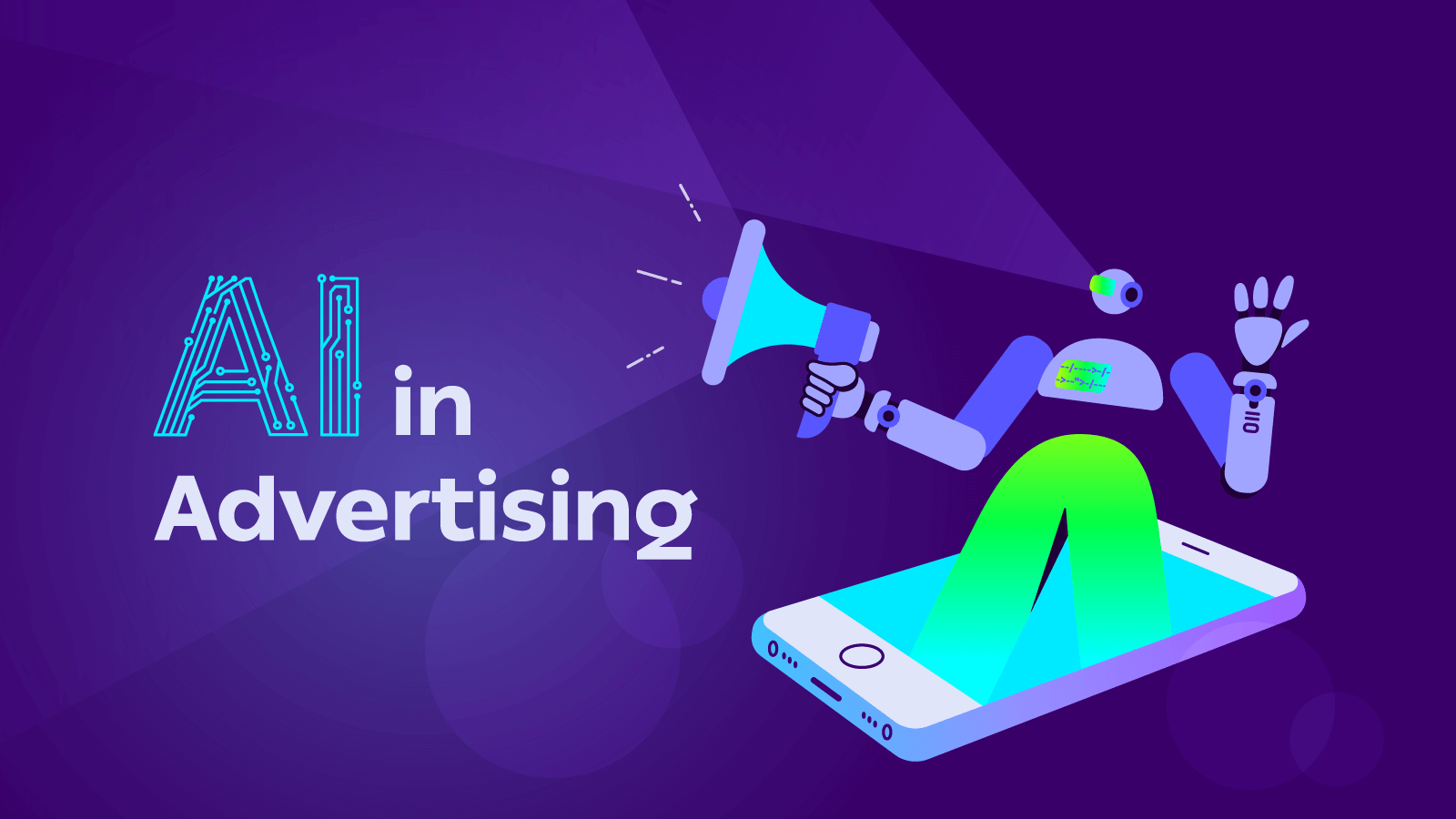
Leave a Reply